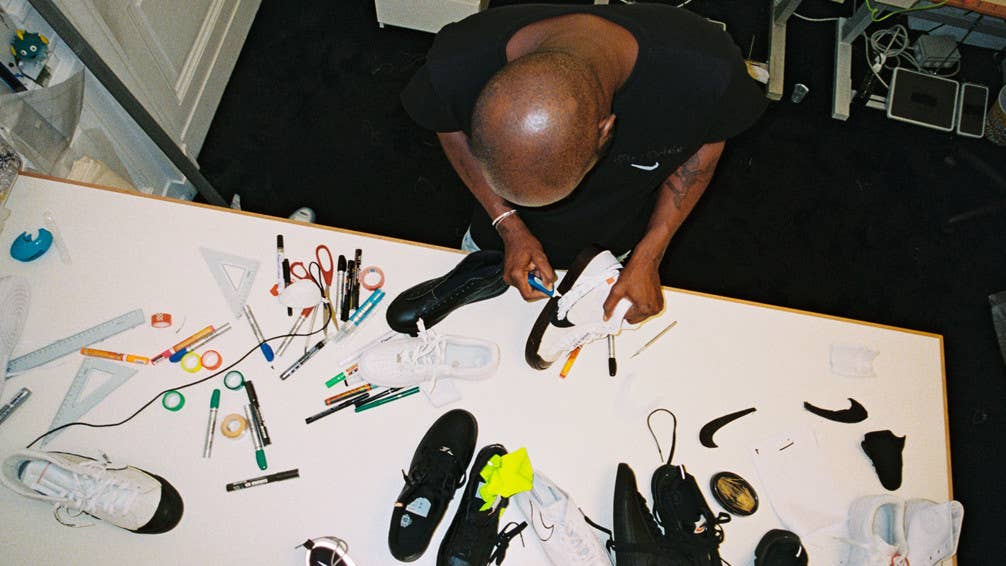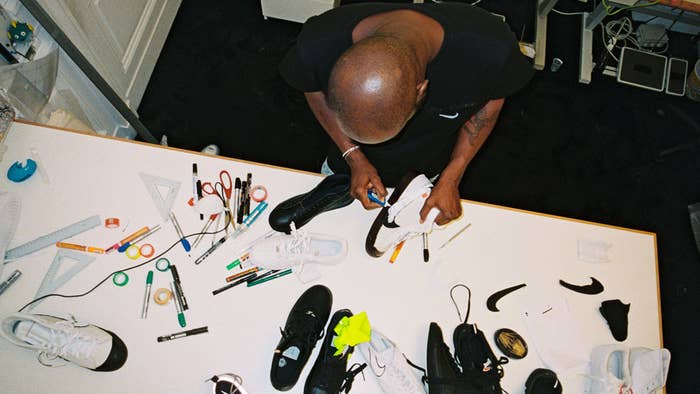
It seemed like time waited for Virgil Abloh. That was the only explanation for how impossibly prolific he was—in design, in DJing, in blending together subcultures at all levels of fashion. The Off-White founder and artistic director of Louis Vuitton menswear bent time with his will, stretching it out to fit what would have still been an immense body of work across 50 years into the past decade.
Abloh died on Sunday after a private two-year battle with cardiac angiosarcoma, a rare form of cancer. He was 41. His accomplishments in collectible footwear showed how well he understood what the world wanted, helping to make him not just a designer but a pop cultural figure.
Abloh’s mark on sneakers is indelible. His initials appeared in the cryptic text string underneath the sockliner of the Nike Air Yeezy 2, the Nike sequel sneaker from Kanye West, who Abloh worked for as the creative director of DONDA. His handwriting appeared on countless more pieces of footwear that he would sign with thick black text and quotation marks for celebrities and collectors. He personalized shoes starting with his rollout for The Ten, a seismic collaboration with Nike from 2017 that boldly reimagined how its most iconic sneakers could look.
Abloh’s punctuation made sneakers postmodern; he took them apart to remind us what they could contain. Using a Sharpie to cross out the old rules, he redefined what was possible. Among his greatest gifts is a set of tools he left for the next generation to do it again.
His relationship with sneakers was somewhere between tourist and purist, two poles that Abloh used to define his work. Abloh understood their cultural value from a young age, having grown up near Chicago with Michael Jordan as his Superman. He treasured Air Jordans as a kid but did not make collecting sneakers part of his identity as an adult.
“My own personal thing is I’m not a sneakerhead,” he said in a 2017 lecture at Harvard. “I just wear the same shoes for a really long time, and then I just go on to another. But I understand the sort of passion for them.”
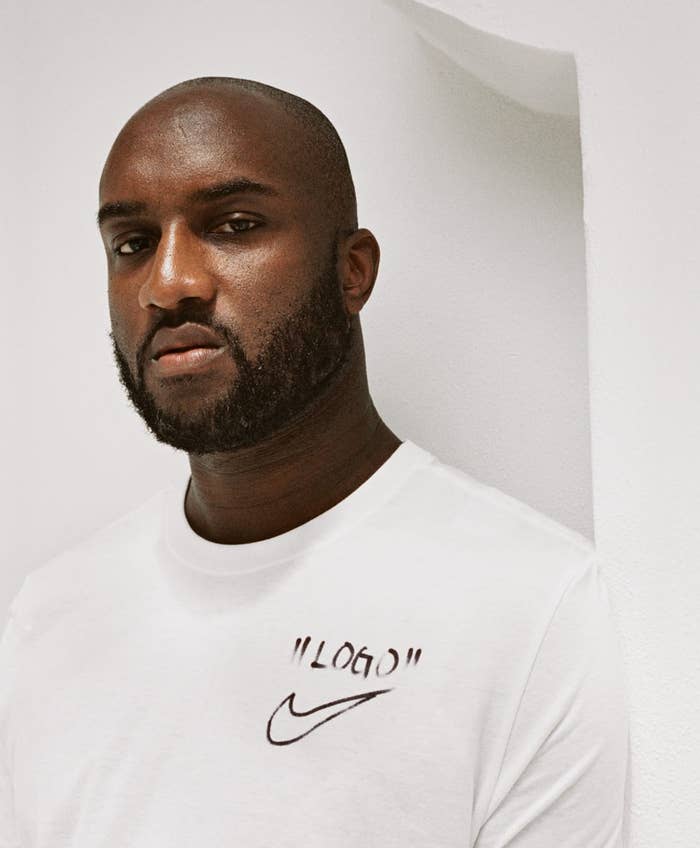
The references in his footwear portfolio showed that he was fluent in sneakers. His stance on the Dunk was informed by a 2001 piece in The Fader on Paul Mittleman, then the creative director of Stüssy. After Abloh died on Sunday, Fat Joe, who helped popularize sneaker hoarding, revealed that the designer had reached out to him about making an Air Force 1 based on Joe’s old Terror Squad-exclusive versions of the sneaker. The gestures in his footwear designs toward the true obsessives gave his work in the space depth.
Abloh knew the importance of the crispy white Air Force 1, although he was not a proponent of it—earlier this year he described himself as battling the purists who kept their pairs clean, and in a blog post from 2013 said he didn’t want his fashion feeling brand new. This idea was communicated through The Ten, a collection designed as a reaction to what he saw as the too-perfect, microwaved feel of brand-new Nikes.
The Ten, which debuted in fall 2017, was his most ambitious project in sneakers. Earlier in the decade, Kanye West had very publicly complained that Nike would not allow him to make more than a Yeezy signature shoe every few years. Here was Abloh, who came from the school of Kanye, with 10 remixes of existing sneakers that pushed how Nike branding could look. His Nike work only grew from there, expanding the scope of what a collaboration with the sportswear brand could be and giving him more product releases than some signature athletes get.
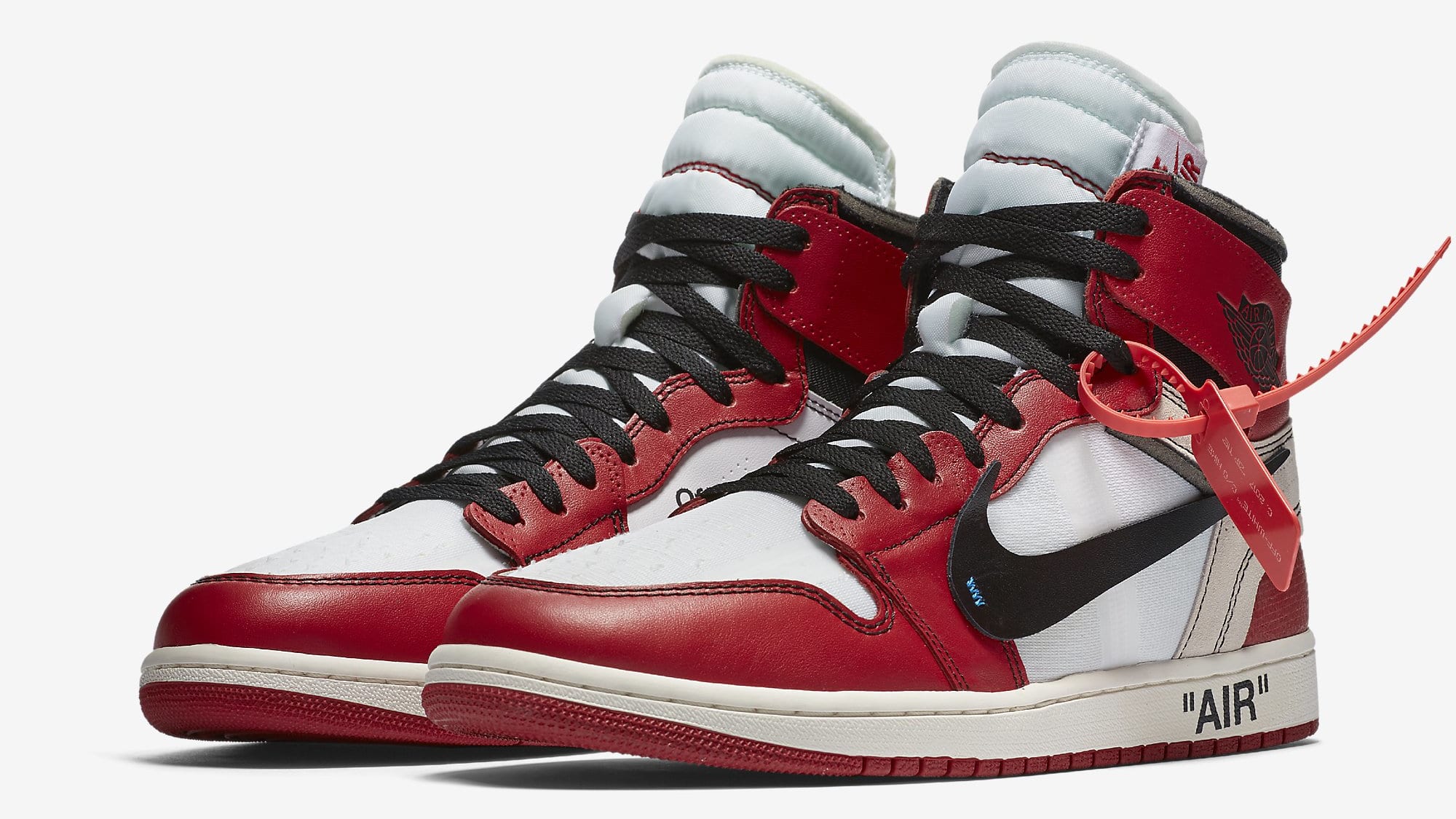
The shoes did not bear Abloh’s name, so in purely nominal terms, they were not signature shoes, but they were distinctly his. One Swoosh was tacked on so gently it looked like it might peel off, another dipped below the upper to creep onto the midsole. Through his Off-White collaborations, Abloh convinced Nike to go further. He imbued in them a balance between respect and cheek.
He jammed an X-Acto knife in the sole of an Air Jordan 1 to make sure the air was really there and then put an “AIR” label there as the most literal proof of his findings available. His first Air Force 1s had Frankenstein stitches, but they were crafted by Matt Kilgore, the son of the Air Force 1’s original designer, Bruce Kilgore. He made sneakers rough so that they looked precious, not as though they were preserved in shrink wrap, but as though they were loved through regular use.
He injected those first Off-White x Nikes with a sort of imperfect handmade quality—he wanted new sneakers to have the same soul as a battered pair of Air Jordan 1s from 1985. Their exposed edges and unfinished parts were meant to show the tech inside the shoes, but they were also a reminder that Virgil was here. The choices helped a range of Nike classics feel more human and less robotic. They said that ideas in the sneakers were not static, but instead alive and humming.
Abloh knew the boundaries of these designs, which is why he was able to challenge them. The goal was to create something that wasn’t allowed to exist before, like an Air Jordan 1 that looked like it was falling apart or a pair of Converse Chuck Taylors with a giant Jim Joe-sketched Swoosh slicing across the upper.
“I love if you could make impossible product,” Abloh said at his Harvard lecture in 2017, explaining his Nike work. “Product that doesn’t seem like it would make it through a legal department.”
The ultimate expression of this is the forthcoming Louis Vuitton x Nike Air Force 1 partnership he engineered, which legitimized a dream from hip-hop fashion that began as a bootleg in the 1980s. He brought skateboarding to Louis Vuitton, too, giving a signature model to skater Lucien Clarke that drew on archival designs from the genre. He lifted streetwear to a new pinnacle by elevating silhouettes into institutions that couldn’t previously understand them.
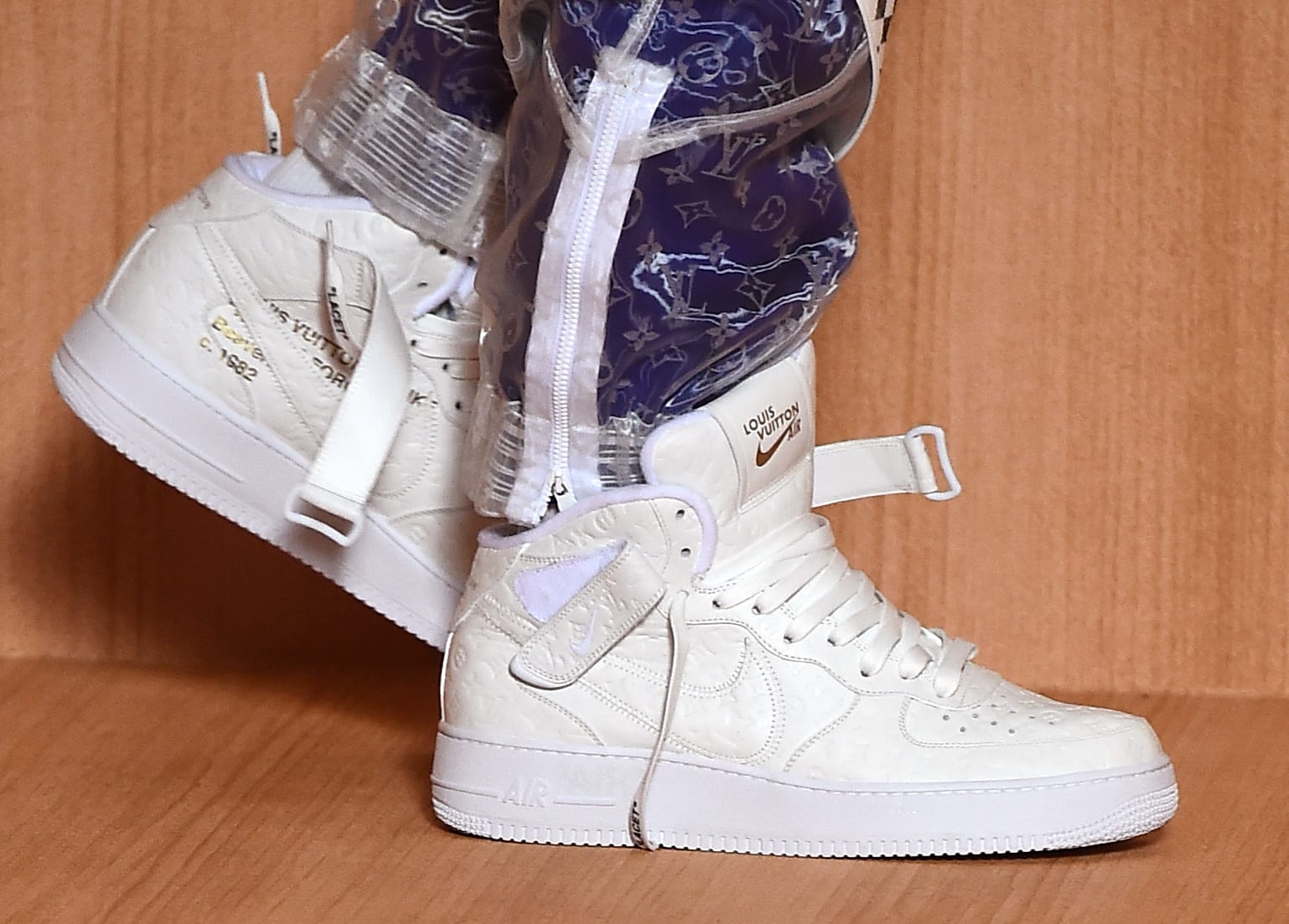
In the first press release for The Ten in 2017, he described Nike’s sneakers as museum-worthy pieces of art comparable to “a sculpture of David or the Mona Lisa.” Just two years later he was actually working with museums to release his sneakers, dropping limited colorways of the Air Force 1 in collaboration with the Museum of Modern Art, the Museum of Contemporary Art Chicago, and, later, the Institute of Contemporary Art.
Though Abloh’s work existed in the highest echelons of luxury fashion and sportswear, and his sneakers were generally difficult to obtain because of the hype attached, exclusivity was not the point. The point was closing the gap. He was a man who looked at boundaries—between Black designers and Europe’s luxury houses, between Futura and Paris Fashion Week, between Givenchy and skateboarding—and saw no reason for them to exist.
He was a magnetic force drawing worlds and scenes together. The “Off Campus” Nike event on Wall Street that accompanied the first release of The Ten in 2017 hosted speakers like Spike Lee, skater Eric Koston, and rapper Vince Staples. The audience was equally diverse; even Adidas employees were present to witness what Abloh had built.
If Abloh’s output felt hasty, it was because he was racing to match the pace of his own ideas. The original series of Off-White Nikes from 2017 took just 10 months from their conception to their release; usually Nike’s timeline for footwear creation is 18 months. Abloh said that most of the design decisions for the shoes in The Ten were made within the first three hours. He did the Off-White x Air Jordan 1 in one sitting.
For Abloh, the tempo was a necessity dictated by the vast amount of work he would give the world.
“Once I realized that it’s OK to not be a perfectionist,” he said, “all of a sudden I can do a million things at once and go to sleep at night.”
The amount of things that he did is unmatched. This summer alone, Off-White released 50 different colorways of Nike Dunks. The collaboration was bookended by a white and a black pair, the grey ones in between fulfilling Abloh’s aphorism of “defining the gray area between black and white as the color Off-White.” Nike’s CEO John Donahoe described that launch as a success that would help the brand redefine exclusivity at scale.
To discern how best to approach the daunting task of releasing 50 pairs of coveted Off-White Nikes in a fair manner, Abloh sought to understand what was broken in sneaker release systems. Though he was a titan, he still engaged in conversation in niche corners of the sneaker internet like a layman.

Between battling cancer in private and leading two of the world’s most powerful brands, he found time to explain himself on Instagram. In October, he responded to social media critique of the new Off-White x Air Jordan 2, breaking down the changes he made to the shoe and what they meant. Abloh did this because he still saw himself communicating on the same level as his millions of followers.
“I am the kid from the comments, too,” he said in a 2020 interview for Esquire. “I’m the kid that wasn’t given an opportunity to design, much like anyone else.”
He shared his rationale so openly and frequently because he wanted others to enjoy the same access and freedom that he had. When he showed in Paris, he created space for Black artists at the front rows of fashion shows. When he spoke at universities, he did so to prep the people who would follow in his wake.
“I just want to make sure that the door is open for a room of these kids to feel like they can design fashion and be on a runway too,” Abloh said in a 2017 interview.
Showing his work was just as important as the work itself. If you couldn’t buy a pair of Off-White x Nikes, he wanted you to get a can of spray paint and some zip ties from Home Depot to make a pair for yourself. Even the garniture had purpose. The reason his sneakers always came with extra shoelaces was to give the people who had them the ability to turn any sneaker into an Off-White design by relacing them.

Abloh was focused on making sure he made available a set of tools. He, like another designer who helped advance Nike’s visual language, was trained as an architect and hence knew the value in creating a blueprint. One of his many websites features a step-by-step walkthrough explaining how to build a brand. The lectures at the Off Campus series in 2017 were intended to galvanize the next class of collaborators.
For everything he gave the world of sneakers, this was his most generous act. He created a set of instructions showing exactly how he claimed his spot atop the fashion world. The website cataloging his Nike work was crammed with documents from the process in an attempt to crack open the source code of working with lofty brands. He was available to all, his far-reaching energy beaming out from Instagram DMs and WhatsApp chats. Abloh adopted largesse as a duty. As soon as he’d arrived, he turned around to let the next wave of makers in.
Like some of his sneakers—the Air Maxes with exposed stitching or the Jordans with foam spilling out of their tongue—this is a work still in progress. It’s a mission that will expand far beyond the years he spent on Earth. The decades ahead will owe a significant amount to Virgil Abloh. His time is not done. At the top of his website, the clock is still ticking.

